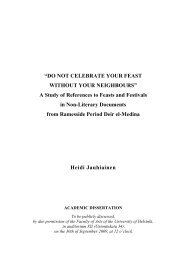BIA
bia51
bia51
Create successful ePaper yourself
Turn your PDF publications into a flip-book with our unique Google optimized e-Paper software.
FÉVRIER 2015<br />
The first phase, completed in 2008,<br />
consolidated the mosque’s foundations, putting<br />
an end to the leakage of subterranean water<br />
into the foundations by installing a new<br />
drainage system. The faulty electricity system<br />
was also replaced.<br />
The second phase is to start soon and<br />
includes restoration of the minaret, the dome<br />
and the columns. “The second phase of the<br />
project will be more holistic in scope,” said<br />
Minister of Antiquities Mamdûh al-Damâtî. The<br />
floor of the open courtyard will be paved with<br />
tiles similar to those used in the original<br />
design, while the four halls around the open<br />
court will be covered in a manner consistent<br />
with the mosque’s architectural style to protect<br />
the edifice from rain. A new lighting system will<br />
be also installed.<br />
The third and final phase will include the<br />
restoration of the decorative features inside<br />
and outside the mosque building.<br />
Sultan al-Zâhir Baybars was one of the<br />
greatest of the Mameluke sultans who ruled<br />
Egypt in the mediaeval period, and he is<br />
remembered for his battles against the Mongols<br />
and the Crusaders. Baybars possessed unique<br />
qualities that enabled him to rise from the<br />
position of a slave to become the ruler of<br />
Egypt from 1260 to 1277 CE. As a military<br />
leader, he accomplished enormous<br />
achievements for his adopted country. He<br />
originally came from Central Asia and what is<br />
now Kazakhstan. He established good relations<br />
with many foreign nations, sending<br />
ambassadors to the Byzantine Empire and the<br />
kingdom of Sicily, and signing commercial<br />
treaties with Christian kings in Spain.<br />
Baybars’s great ideal was Salâh al-Dîn al-<br />
Ayyûbî (Saladin), the military leader and former<br />
Egyptian sultan who conducted holy war<br />
against Crusader strongholds in the Middle<br />
East. Baybars rebuilt the citadels and fortresses<br />
in Syria that had been destroyed by the<br />
Mongol invasion at the beginning of his rule,<br />
and he built advanced military infrastructure<br />
including new arsenals, warships and cargo<br />
vessels.<br />
In 1267, Baybars built the mosque that<br />
bears his name in the al-Husayniyya district of<br />
Cairo, now known as al-Dâhir, a corruption of<br />
al-Zâhir, the sultan’s first name. The mosque<br />
covers an area of 10,000 square metres<br />
enclosed by a 10-metre wall. It has three<br />
monumental projecting entrances. The main one<br />
in the western wall leads to a passageway with<br />
a domed ceiling at the beginning and ends<br />
with a shallow dome.<br />
Inside the mosque is a square courtyard<br />
surrounded on four sides by aisles. The most<br />
distinguished feature of the mosque is the<br />
chamber that precedes the mihrâb, which<br />
indicates the direction of Mecca, which is a<br />
square structure topped by a redbrick dome.<br />
The southern aisle consists of six<br />
colonnades; those on the east and west<br />
consist of three colonnades each, and the<br />
northern aisle has only two colonnades. All the<br />
latter’s arches are supported by marble<br />
columns.<br />
The original doors of the mosque resembled<br />
those of the Madrasa al-Zâhiriyya in Cairo,<br />
while the dome would have been as large as<br />
that of al-Shâfi‘î Mosque. The rest of the plan<br />
is very similar in design to that of the Fatimid<br />
al-Hâkim Mosque, built 250 years earlier, but<br />
some modern scholars argue that it looks more<br />
like a fortress and consider it to be a symbol<br />
of the triumph of Sunni Islam.<br />
For Baybars, constructing a mosque of this<br />
size was part of his desire to establish his<br />
authority as a legitimate Muslim ruler. Raw<br />
materials for its construction were imported<br />
from all corners of the empire. Marble columns<br />
and wood were taken from the citadel of Jaffa,<br />
which Baybars had taken from the Crusaders.<br />
The marble was used in the facing of the<br />
mihrâb and the wood in the construction of<br />
the maqsûra (chapel).<br />
The mosque has been through many<br />
changes since it was built at the end of the<br />
13 th century. According to historians, prayers<br />
<strong>BIA</strong> LI — Janvier/Juin 2015 50



